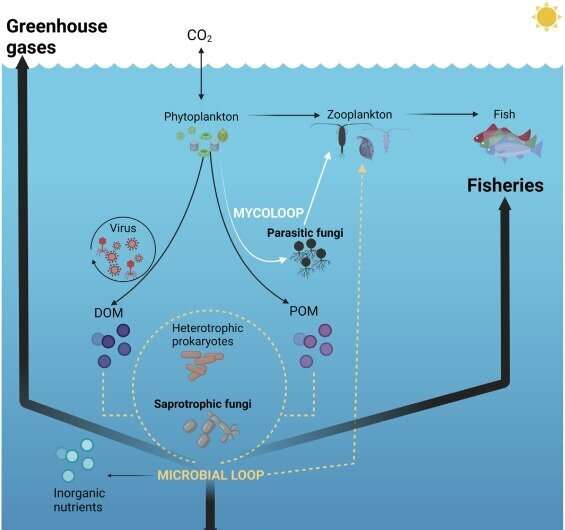This article has been reviewed according to Science X's editorial process and policies. Editors have highlighted the following attributes while ensuring the content's credibility:
fact-checked
peer-reviewed publication
trusted source
proofread
The rise of pelagic fungi and their crucial role in oceanic ecosystems

Fungi play a vital and previously neglected role in the complex tapestry of marine ecosystems, a study by Eva Breyer and Federico Baltar of the University of Vienna reveals. The results have now been published in the journal Trends in Ecology & Evolution.
Traditionally overlooked and underestimated, recent findings have put the spotlight on the profound importance of pelagic fungi (mycoplankton) as valuable members of oceanic pelagic ecosystems. Thanks to recent technological advances, the scientific community can now harness cutting-edge tools to uncover, characterize, and understand the abundance, diversity, and functional roles played by pelagic fungal taxa and communities within the oceanic realm.
Through a comprehensive review of the current knowledge on mycoplankton ecology, Breyer and Baltar shed light on the ubiquity of pelagic fungi and emphasize their crucial role in the ecology of the oceans. "Pelagic fungi, previously overlooked, are found extensively throughout the water column in every ocean basin. And not only that, these fungi play an active role in the degradation of organic matter and the cycling of nutrients, highlighting their significance in the functioning of marine ecosystems," says Baltar.
The integration of pelagic fungi into our scientific framework not only enhances our knowledge of marine ecosystems but also bridges the realms of terrestrial and freshwater fungal ecology, expanding the global relevance of fungi in diverse natural environments. Baltar explains, "Incorporating the role of mycoplankton in ecological models will enhance our comprehension of organic matter cycling and promote better management and conservation practices for our oceans."
More information: Eva Breyer et al, The largely neglected ecological role of oceanic pelagic fungi, Trends in Ecology & Evolution (2023). DOI: 10.1016/j.tree.2023.05.002
Journal information: Trends in Ecology & Evolution
Provided by University of Vienna




















